|
ARBOR Technology Gladius 5
Elegant, state-of-the-art, and impressively rugged 5.5-inch Android handheld device for IoT (Internet of Things) and numerous other applications
By Conrad H. Blickenstorfer; photography by Carol Cotton
ARBOR Technology, a Taiwan-based ISO-9001 certified embedded and networking manufacturer founded in 1993, announced the Gladius 5 in Summer 2014 as a general-purpose large-screen rugged Android handheld, and also as a building block for emerging IoT applications. RuggedPCReview has now had a chance for extended hands-on with the Gladius 5, and this report presents our review and observations.
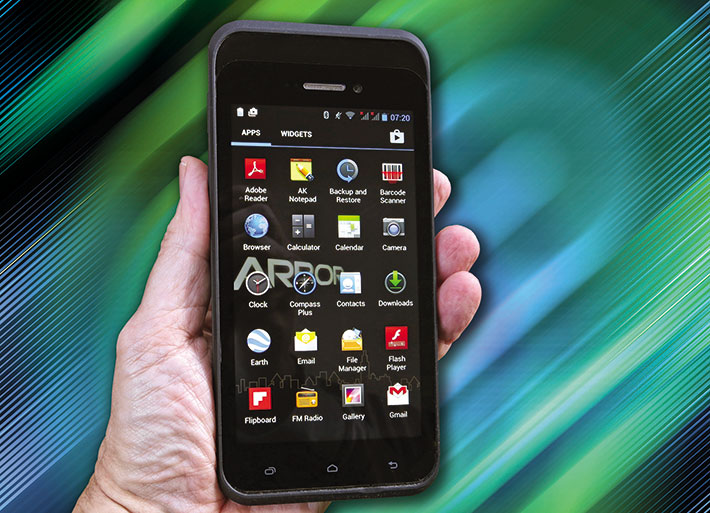
ARBOR calls the Gladius 5 (as well as the larger Gladius 8) "rugged IoT handheld devices," and that requires a bit of explanation.
Gladius 5 and IoT, the Internet of Things
IoT stands for "Internet of Things" and describes a paradigm where the current internet communication between people or people with machines is extended to "things" communicating as well.  "Things" refers to anything — such as homes, doors, wash machines, cars, subsystems, etc. — that, via sensors, can collect data and pass that data on for processing and action. The IoT infrastructure consists of four layers, those being "Things" refers to anything — such as homes, doors, wash machines, cars, subsystems, etc. — that, via sensors, can collect data and pass that data on for processing and action. The IoT infrastructure consists of four layers, those being
- a) sensors devices,
- b) IoT gateways that share and filter data,
- c) intelligent systems and networks that analyze and manage data,
- d) the cloud with IoT systems analysis and instant feedback, resulting in increased efficiency and reduced costs.
Why is this a big thing? Because experts estimate some 50 billion IoT devices and many trillions of US dollars in increased revenue and reduced cost within the next ten years. And where does the Gladius 5 fit in as a "handheld IoT device?" Both as a mobile sensor device and as an IoT gateway.
As a sensor device, the Gladius 5 uses its various data sensing and collection systems. Those include, on the data sensing side, an ambient light sensor, an accelerometer, a 3-axis digital gyroscope, a barometer, and a digital compass. On the data collection side, the Gladius 5 employs an RFID/NFC reader (peer-to-peer, tag reader/writer, and card emulation modes are available), an industrial-grade 1D barcode reader or 1D/2D imager, as well as an 12.6mp auto-focus documentation camera (in addition to a 2mp frontal vidcam).
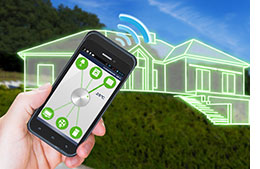 As a IoT gateway device, the Gladius 5 can aggregate its polled and collected data, filter it, do desired local processing, and then pass it on to higher level gateways and networks either via Bluetooth, WiFi or mobile broadband. Once the higher level intelligent systems and/or cloud-based big data and IoT apps have done their processing, the Gladius 5 may then receive real-time feedback for human or machine action. As a IoT gateway device, the Gladius 5 can aggregate its polled and collected data, filter it, do desired local processing, and then pass it on to higher level gateways and networks either via Bluetooth, WiFi or mobile broadband. Once the higher level intelligent systems and/or cloud-based big data and IoT apps have done their processing, the Gladius 5 may then receive real-time feedback for human or machine action.
In order to reliably fill its role as both a mobile sensor and gateway device, the Gladius must be tough enough to hold up to whatever conditions it may encounter in the field. To that end, the device carries IP65 sealing where the "6" stands for it being completely dustproof, and the "5" for the ability to handle low-pressure water jets from all directions. The Gladius can also handle 5-foot drops and operating temperatures between -4 and 140 degrees Fahrenheit. ARBOR claims additional MIL-STD-810G testing, but we haven't seen a complete list yet. The display is protected by Corning Gorilla Glass 3.
Contemporary smartphone size, but much tougher
How big should an IoT handheld be? The smartphone form factor seems appropriate since, after all, an IoT device must be able to perform a variety of complex computing functions. ARBOR feels the same way and from upfront the Gladius 5 looks so much like a modern smartphone that I picked it up several times when I meant to pick up my personal iPhone 6 Plus in its protective black rubber boot. The Gladius 5 is a bit larger yet than the big iPhone 6 Plus, but overall it looks just like what currently is considered a properly dimensioned phone.
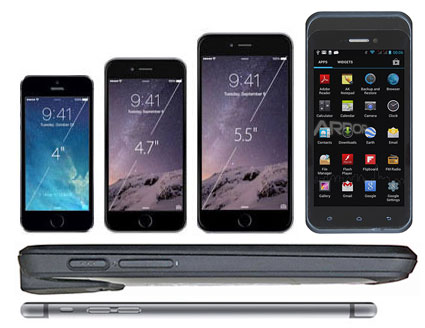 The picture to the right shows where the Gladius 5 fits in terms of size. The lineup shows — from left to right and in scale — Apple's by now tiny-looking iPhone 5, the standard iPhone 6, the big iPhone 6 Plus, and then ARBOR's compact IoT device. The picture to the right shows where the Gladius 5 fits in terms of size. The lineup shows — from left to right and in scale — Apple's by now tiny-looking iPhone 5, the standard iPhone 6, the big iPhone 6 Plus, and then ARBOR's compact IoT device.
The Gladius 5 measures 6.9 x 3.3 inches, versus the iPhone 6 Plus's 6.2 x 3.1. Its 5.5 inch diagonal screen size is the same as that of the 6 Plus, the same as many of the current leading consumer smartphones, and dwarfing the 4-inch iPhone 5 whose display would have been considered very large for a handheld just a few years ago.
Screen size isn't everything, of course. As a ruggedized device, the Gladius 5 is 0.63 inches thick, and weighs 9.9 ounces. That's substantially thicker and heavier than today's consumer smartphones. Note however that this is actually thinner and lighter than early Microsoft platform Pocket PCs that were the ancestors of today's smartphones, and those were not rugged devices and had much smaller screens.
The picture above also shows how the Gladius 5 compares in thickness to the iPhone 6 Plus.
It's interesting that although the Gladius 5 looks just like a consumer phone from the front, it's actually a completely different device, one that's much tougher and offers much more functionality. Some consumer phone companies now offer versions of their phones that look largely the same as their standard issue models but are better able to withstand abuse and the elements, but even those are still far less rigid and durable than the Gladius 5.
IoT device technology
Those interested in a handheld such as the Gladius 5 may plan on using it in a variety of potential capacities, ranging from rugged handheld, to dedicated IoT device, to data capture device, to simply a tough version of a modern smartphone. What sort of specs and technologies did ARBOR provide to help the Gladius 5 address all these requirements?
 Powering everything under the hood is a 1.0GHz quad-core Cortex A7 MediaTek MTK6589 processor that's based on the ARMv7 instruction set. It also includes an PowerVR SGX544 graphics processor that's in charge of parallel graphics acceleration. The MTK6589 is a popular chip introduced in mid-2013 and being the heart of a long list of smartphones. It uses contemporary 28nm process technology and is competitive with its mostly QuadComm-based rivals. Powering everything under the hood is a 1.0GHz quad-core Cortex A7 MediaTek MTK6589 processor that's based on the ARMv7 instruction set. It also includes an PowerVR SGX544 graphics processor that's in charge of parallel graphics acceleration. The MTK6589 is a popular chip introduced in mid-2013 and being the heart of a long list of smartphones. It uses contemporary 28nm process technology and is competitive with its mostly QuadComm-based rivals.
There's a gigabyte of LPDDR RAM and 8GB of Flash for storage. While 8GB doesn't look like much compared to the 16/64/128GB available in iPhones, it's more than adequate if the device can use expansion cards. So for the Gladius 5 it's the 8GB and what is in its user-accessible micro SDHC card slot inside the battery compartment.
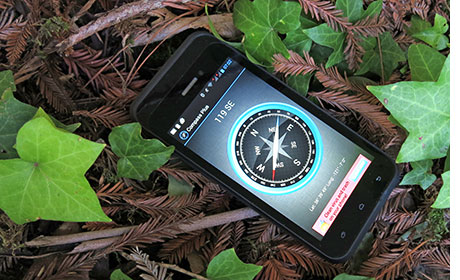 There is an 12.6mp documentation autofocus camera with LED flash on the backside. Customers may also opt for an additional 2mp vidcam in the front, but it's either that camera or an integrated scanner but not both. As for the documentation camera's 12.6mp imager size, the megapixel count is being pushed by some consumer smartphone manufacturers to differentiate themselves, and we certainly welcome that trend. Apple stayed with 8mp in its iPhone 6 and 6 Plus, and that's still what most rugged smartphones/handhelds currently offer, so ARBOR is ahead of the game. There is an 12.6mp documentation autofocus camera with LED flash on the backside. Customers may also opt for an additional 2mp vidcam in the front, but it's either that camera or an integrated scanner but not both. As for the documentation camera's 12.6mp imager size, the megapixel count is being pushed by some consumer smartphone manufacturers to differentiate themselves, and we certainly welcome that trend. Apple stayed with 8mp in its iPhone 6 and 6 Plus, and that's still what most rugged smartphones/handhelds currently offer, so ARBOR is ahead of the game.
The Gladius 5 has a user-accessible and easily removable 13.3 watt-hour Li-Ion battery. That's roughly 20% more capacity than what the iPhone 6 Plus has, so ARBOR's estimate of "up to 8 hours" of battery life between charges sounds reasonable. Charging is via a standard micro-USB port, and the Gladius 5 also supports Qi standard wireless charging either via desktop or vehicle wireless chargers (see Qi wiki). Very cool.
Even in this day and age of giant smartphones, the Gladius 5's 5.5 inch display is larger than virtually any display found on rugged and industrial handheld devices. Those who intend to use the device for mapping and GIS applications will certainly welcome the extra screen area.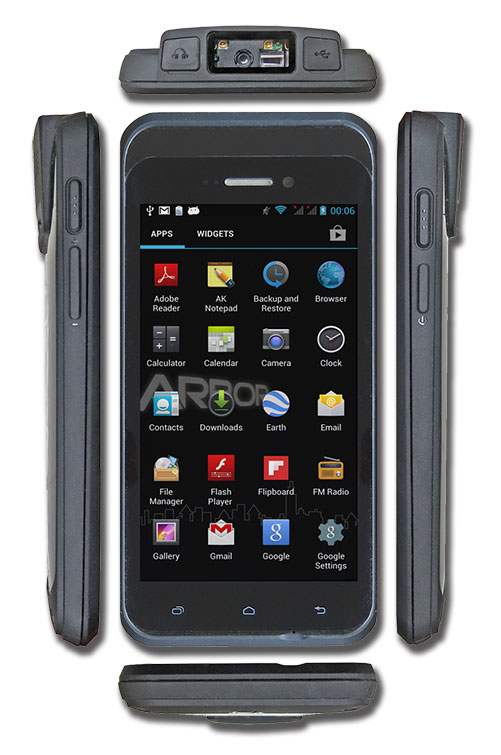 This being an Android device, it's no surprise that the Gladius 5 uses the projected capacitive ("procap") multi-touch technology pioneered in smartphones rather than a resistive digitizer as was used in almost all older handhelds and still in a good number of more recent ones. This being an Android device, it's no surprise that the Gladius 5 uses the projected capacitive ("procap") multi-touch technology pioneered in smartphones rather than a resistive digitizer as was used in almost all older handhelds and still in a good number of more recent ones.
The use of capacitive multi-touch in industrial devices is a relatively recent development, and only came after much discussion of the technology's pros and cons (including its inability to work in the rain or with gloves on).
Fact, of course, is that it rains for consumers, too, and consumer market procap smartphones are selling by the hundreds of millions. This is a case where the benefits of what began as a consumer market technology outweigh the limitations.
All modern smartphones have sensors, and their presence is especially important in a device that's also designed for IoT duty. As a result, ARBOR designed the Gladius 5 with a proximity sensor, a 3-axis accelerometer, a 3-axis magnetic field, a barometer, and an ambient light sensor to adjust backlight intensity.
Wired connectivity is via micro-USB 2.0. For wireless connectivity there is Bluetooth v4.0 + EDR, 802.11b/g/n WiFi, NFC, both A-GPS and dedicated GPS, and mobile broadband of the WCDMA/GSM variety.
The picture to the right shows the Gladius 5 from the front and from all four sides. It's a very elegant design that combines the all-black glossy look of a modern consumer smartphone with the protective rubber-cladding, meticulous sealing, and space for industrial grade expansion of a vertical market device.
Going around the Gladius 5 reveals a number of controls but not much in terms of ports. This is a sealed device, and that means the fewer openings that must be protected against immersion the better.
The left side has a programmable button (which can be used to trigger the scanner) and a volume up/down rocker. On the right side are another programmable/scanner button and the unit's power button. On top are, beneath protective hinged rubber plugs, the unit's earphone jack and micro-USB port. The bottom does not contain any controls or ports.
The front of the Gladius 5 is dominated by the large display whose surface glass extends well beyond the perimeter of the LCD, a characteristic common to virtually all capacitive touch devices, so that fingers do not bump into a border during touch. The protective rubber cladding of the Gladius 5 does make for a border around the perimeter of the device, but it's far enough away from the extent of the LCD to not get in the way, and it only sticks up by a millimeter or so.
Beneath the display are three Android controls (Menu, Home, Back), implemented here as capacitive touch areas with icons outlined in white and illuminated from the inside when the Gladius is in use. That's a bit different from the currently standard trio of Android buttons, those being Multitask, Home, and Back. The "Menu" Android button officially vanished with version 4.0, but apparently ARBOR considered "Menu" more important than "Multitask."
What's inside the Gladius 5?
There was a time when form followed function in cellphone design. Mobile phones were supposed to be small, handy devices (in most European countries the word for mobile phone is actually "handy") that fit anywhere and could be used anywhere. That is no longer possible with today's big-screen waver-thin consumer phones where fashion trends have almost completely replaced function.
In stark contrast, industrial handhelds, while certainly borrowing useful ideas from consumer smartphones, remain very much tools for the job. So while the Gladius 5 at first sight looks just like one of Apple's boutique-like phones, it's really an entirely different animal. How different? Let's find out.

The pictures above show the backside of the Gladius 5 with and without its battery compartment cover on. Inbetween the two images you can see the unit's card slots inside the battery compartment (top) as well as the replaceable battery itself (bottom). The 3.7 Volt/3,600mAH Lithium-Ion battery is flat, rectangular, and accessible enough to be exchanged for a freshly charged battery on the fly. The Gladius is different from most enterprise handhelds available in the US in that it has two SIM card slots, covering voice and data needs. If two cards are installed, an app lets you select which of the two separate mobile connections/accounts to use.
The thin glossy battery compartment cover consists of PC+ABS. It has a thumb screw securing it in place. There are NFC and WPC antennae integrated into the compartment cover. They make contact with two surface mount pins each. An intricate rubber pressure seals sits on the housing part of the battery compartment.
In terms of overall construction, the Gladius 5 has a rigid magnesium frame attached to the front part of the PC+ABS housing, with the display mounted on one side of the frame and the main and subsidiary boards mounted on the other.
The bottom half of the housing PC+ABS polycarbonate as well. The two halves are secured together via 14 small Philips head screws. Once those are undone, the two halves separate easily, with no wires that could break or come loose between them. Instead, ARBOR is using surface mount pressure contact (speakers and antennae are examples). Sealing between the two halves is via a tongue-and-groove design with a thin rubber o-ring sitting in the bottom-part groove. The ring is replaceable and it's not likely to crimp, sitting in a rectangular track without crazy corners, etc.
The image below shows what it looks like inside the Gladius 5:
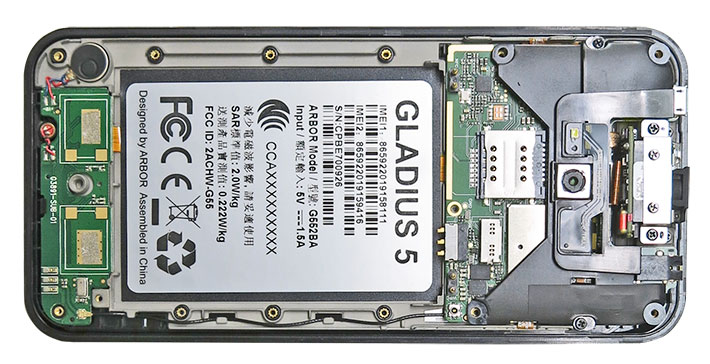
As we're seeing more and more often, part of the main board of the Gladius 5 is covered by a black plastic assembly in much the same way engine compartments of automobiles often have elegant looking plastic cowls that cover components. The cowl here seems part of the device's camera subsystems, with the LED illuminator actually part of the cowl, drawing its power, you guessed it, via surface mount pressure contacts instead of wires.
Unlike consumer products where scanning is done via app and the integrated camera, the Gladius 5 has an industrial grade miniature Honeywell Adaptus N5600 standard range 1D/2D area imager (see N5600 info). Depending on the intended use, ARBOR also offers an optional Honeywell N4300 1D laser scanner (see N4300 info).
The image compilation below shows some of the interesting details of the ARBOR Gladius 5. On the left you can see a close-up of the intricate camera module, on the right an example of the surface-mount connector technology ARBOR seems fond of. The detail shows one of the Gladius 5 speakers with its surface contact arrangement that precludes wires.

Overall, the Gladius 5 is a remarkably clean and well organized design. Particularly impressive is the elegant, functional magnesium frame with its custom-designed main and subsidiary boards that together form a compact, logical and very clean solution.
Contemporary display — 5.5-inch and procap multi-touch
The Gladius 5's 5.5-inch display would have looked positively gigantic for a handheld just two or three years ago. The iPhone launched the modern smartphone era with a 3.5-inch screen, selling tens of millions, and it wasn't until September 2012 that Apple introduced the iPhone 5 with a larger 4.0-inch screen. Since then, of course, the consumer smartphone screen size dam has broken, with even Apple joining the trend initially introduced by Samsung in an effort to somehow differentiate itself from Apple.
As a result, the Gladius 5 display still looks quite large, but not unusually so, and no one will ever say "oh, this screen is too small for me to work on." It certainly also helps that the Gladius display is crisp and sharp. The screen's 1280 x 720 pixel resolution is not quite as high as the full 1920 x 1080 pixel 1080p screen of the iPhone 6 Plus, but 270 dpi is still super-sharp and actually beats the iPad Air's 264 dpi. It's far sharper than the original iPhone (163 dpi), let alone desktop such as the iMac27 this review was written on (about 108 dpi). And it's an IPS (In-Plane Switching) screen, which means it has perfect viewing angles from all directions.
The pictures below show a comparison between the Gladius 5 and an iPhone 6 Plus outdoors, both at maximum brightness. Apple's big 6 Plus is said to have a maximum screen brightness of 550-600 nits. The Gladius 5 specs don't include a nits rating, but under most conditions, it looks almost as bright. Both displays are glossy, so there are reflections outdoors. Most smartphone and tablet users have learned to live with that.

The picture below shows the two devices from the left and the right. Viewing a device from an angle may reveal color shifts in certain types of LCDs, but neither device suffers from that. The screen image remains perfectly viewable in unchanged from any angle.
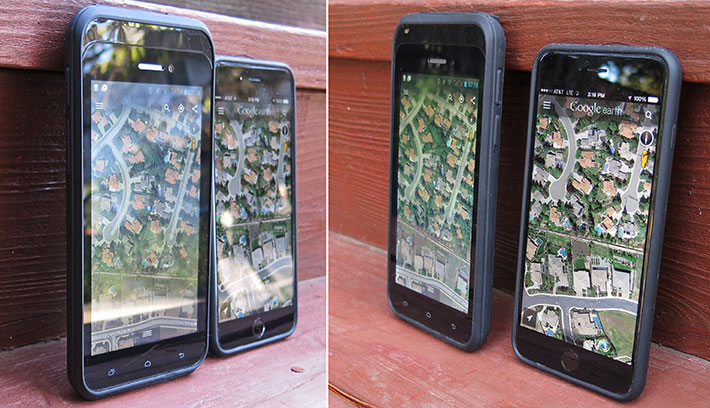
Capacitive multi-touch works as everyone expects from a handheld these days — quickly and effortlessly. The touch controller ARBOR used is more sensitive than that in most earlier capacitive touch devices. That means it can work when wearing certain types of thin gloves. The device doesn't come with a stylus and ARBOR doesn't offer an optional capacitive pen. Any 3rd party capacitive pen will work, though those generic pens with their broad tips don't offer much more accuracy than the tip of a finger. It's not that important anyway as Android was specifically developed for capacitive multi-touch with a finger.
Android versus Windows or Windows Mobile
The Gladius 5 runs Android 4.2, and unlike a number of recently introduced industrial handhelds, there's no corresponding Windows or Windows Mobile based version. Why?
Probably because in consumer markets, the vast majority of non-Apple smartphones run Android, and even compared to Apple, Android has a commanding market share. And even though Windows Embedded Handheld continues to hold on in industrial markets, Android  is now beginning to make inroads there as well. As a result, many providers of ruggedized handhelds now offer both Microsoft and Android based versions of their handhelds or are leaning towards Android. ARBOR's approach seems to be to offer whatever OS platform seems suited best for a certain device class and application; the company offers both Android and Windows in different models of its growing rugged tablet lineup. is now beginning to make inroads there as well. As a result, many providers of ruggedized handhelds now offer both Microsoft and Android based versions of their handhelds or are leaning towards Android. ARBOR's approach seems to be to offer whatever OS platform seems suited best for a certain device class and application; the company offers both Android and Windows in different models of its growing rugged tablet lineup.
Given Android's massive market share, it's quite obvious that Android-based work devices will have instant appeal and familiarity to those who are already using Android smartphones and/or tablets at home or at work. Though often customized by voice and data service providers, the basic workings of the Android interface are very widely known by now, and a very large number of apps are available for download. Android software development and expertise is commonly available, and making Android devices available on the job can save training as well as deployment costs.
Additional Android contemplations
The total number of available apps for a handheld software platform has become a crucially important marketing issue, as is how easily users can download apps. Apple has its slick and massive App Store. Android offers the official 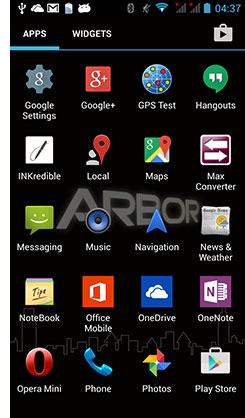 Google Play store, as well as third party alternates such as the Amazon Appstore for Android, Slide ME, and several others. Google Play store, as well as third party alternates such as the Amazon Appstore for Android, Slide ME, and several others.
There is, however, an important difference between consumer and industrial markets here. Whereas a vast number of easily accessible apps is a big plus for consumers, many industrial and enterprise deployers do not want their workforce download (and distracted by) apps into devices used for work. What are the answers to this potential problem?
One approach is to use Android AOSP, which stands for Android Open Source Project, and is an open-source software stack and project, led by Google itself, but without the ability to use the Google Play store and some of the major Google apps. Android AOSP, however, still has access to alternate app stores.
Another possibility is using something like 42Gears.com's SureLock. SureLock replaces the Android desktop and allows control of applications that are available to users. It can even be configured to run in "kiosk mode" with just a single application that is always active. This way, systems integrators or IT personnel can configure units for specific use and applications, eliminating the temptation that comes with a full load of consumer apps.
The Gladius 5 sample unit ARBOR sent us for evaluation came not only with a basic selection of useful apps, but also with the official Google Play store. Google does make it possible to customize the look and feel of an Android device (and ARBOR did add their corporate logo), and organizations can publish their own Android apps or officially sanctioned apps privately to a dedicated company-owned channel on Google Play.
No shortage of apps
The images below are screen shots of a variety of apps the review Gladius 5 came with, and some useful apps we downloaded from Google Play, just like an ARBOR customer might do to personalize his or her own device.
The first series of three screen snaps shows the browser. Web browsing has historically been a frustrating thing for users of handheld computers due to small screen size, low resolution, and lack of processing power. On the Gladius 5, the screen is large enough, there's plenty enough resolution, and processing power is sufficient for a productive browsing experience (though we wouldn't mind a bit of extra speed).
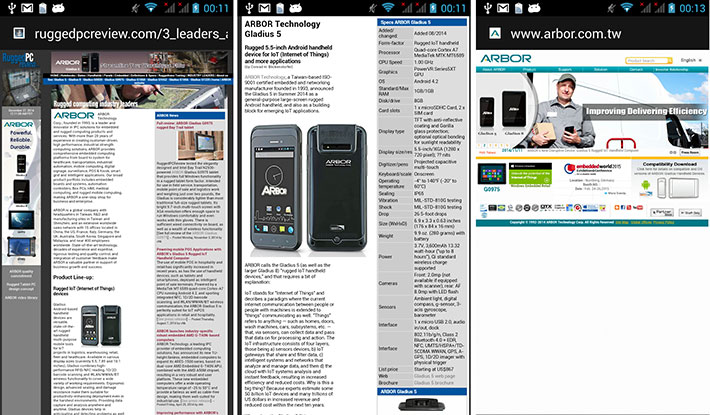
While some Gladius 5 corporate and enterprise customers will likely limit the devices to dedicated applications or perhaps just one task, others will allow personalizing the units to meet individual needs. That might include installing Microsoft's OneDrive to access cloud storage (left), tools such as a handy unit converter (middle), and Skype for calling (right).
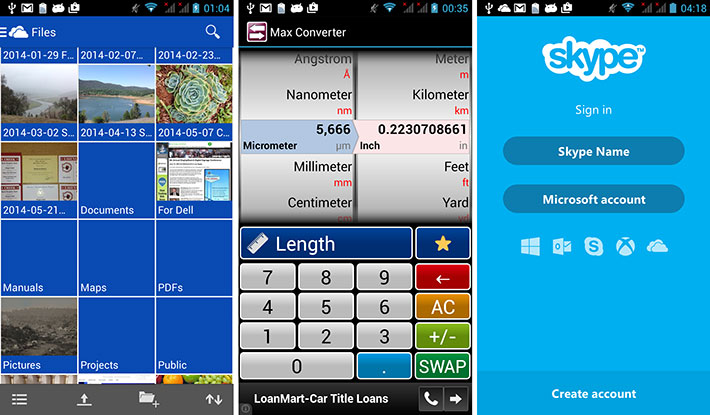
Powerful handhelds such as the Gladius 5 are also often used to record ideas and observations and perhaps do a quick sketch. Users of Microsoft OneNote (left) will appreciate that the app is available for Android. We also downloaded the electronic equivalent of a little yellow notepad (middle), and it's also possible (via apps like INKredible) to do some beautiful calligraphy (or just quick jotting) on the Gladius. The latter, though, is one area where the precision of a stylus would come in handy.
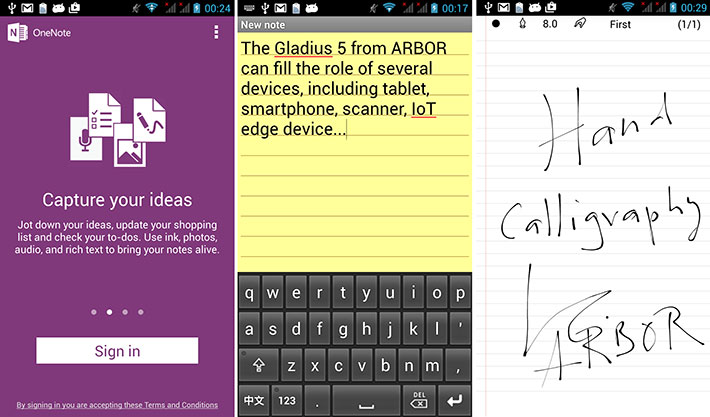
Next on the list of downloads might be Google Earth for mapping, satellite imagery, mapping with traffic information, or Street View. The large size and high resolution of the Gladius 5 display makes mapping and GIS a natural for the device, and there's a large number of GPS apps that show satellite and location data.

There are several office suites available for Android, but enterprise and business users may need Microsoft Office. An Office 365 client is available for Android, and as of November 2014 it no longer requires a paid Office 365 subscription to edit documents and store them in the cloud. Office Mobile, of course, is far from a complete implementation of the full Office 365, but it works just fine.
The scanner app shown in the middle below actually uses the device's documentation camera. It comes in handy for units that do not have the optional industrial grade imager installed (ARBOR does offer a special APK scanner app for the dedicated scanner). The picture on the right is a sample snap of a blueprint sketch on the job.
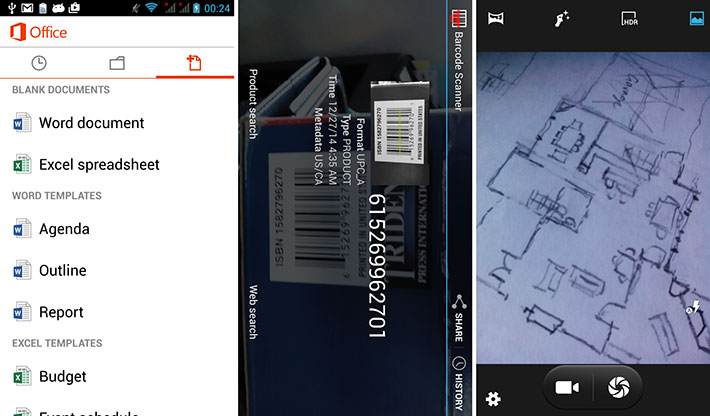
The above is simply a small sample of some of the useful everyday informational and productivity things the Gladius 5 can be used for. Thousands of other apps are available, on top of whatever custom or professional software users may wish to install.
Very good cameras
The ARBOR Gladius 5 has both a front and a rear camera, as one would expect from a modern smartphone. The front one is for video calls and such, and offers 2 megapixel resolution. The rear one is for picture taking and documentation. The specs claimed an 8 megapixel imager, but the pictures we took came out in 4,160 x 3,120 pixel resolution, which is 13 megapixel. Checking with ARBOR revealed that the specs had changed, and the Gladius 5 now has a 13mp imager. Camera settings allow selecting resolutions from just QVGA all the way up to 13mp. Both cameras can be used for stills as well as for video.
By and large, with few exceptions our experience with cameras integrated into rugged vertical market handhelds and tablets has been underwhelming over the years, with even the best ones lagging behind what's available in dedicated point & shoots and consumer smartphones. 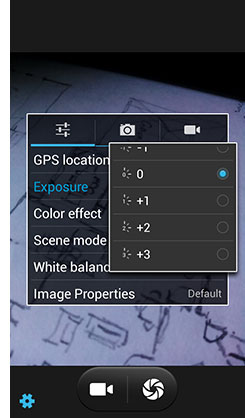 This is starting to change now, possibly through the very wide distribution of Android-based smartphones equipped with good cameras. Whatever the reason, the rear-facing documentation camera of the Gladius 5 is quite good. The test pictures we took with the device were absolutely good enough for most documentation tasks.
This is starting to change now, possibly through the very wide distribution of Android-based smartphones equipped with good cameras. Whatever the reason, the rear-facing documentation camera of the Gladius 5 is quite good. The test pictures we took with the device were absolutely good enough for most documentation tasks.
The screen snap to the right shows some of the camera settings screens, and what it looks like in picture-taking mode.
The user interface is quite elaborate, with 14 scene settings, 7 color effects, 8 white balance settings, +/-3EV exposure control, face detection, 2/10 second self timer, 40 or 99 continuous shots, picture sizes from QVGA all the way up to 8mp, ISO settings from 100 to 1600 and auto, HDR capturing, panorama shooting, and more. When using the front camera, the focus can follow your face automatically, which comes in handy if you move around a lot.
Users can edit pictures right on the Gladius 5. There is a wealth of functions available, including color effects, frames, cropping, straightening, mirroring, numerous filters, and even such advanced operations as sharpening, hue, vibrance and curves. The camera app also supports social media. You can directly send images to Picasa, Messaging, email, Skype, OneDrive or whatever other social media apps you have on the device. And images can also be converted to PDF.
In video mode, there is a special meeting recording setting for audio recording, and the microphone can be turned on and off. There is also time lapse video with a picture taken shot every one to 10 seconds, and users can set video quality. Video appears to record in 720p (1280 x 720 pixel) mode, with no other size settings apparent.
Having all those many settings and features available will be important to some users, but what's most impressive about the Gladius camera apart is its speed and quality. It is well suitable to document jobs both in stills and in video.
The pictures below were shot with the ARBOR Gladius 5 in 13mp mode. Click on the image to bring up a full-size version.
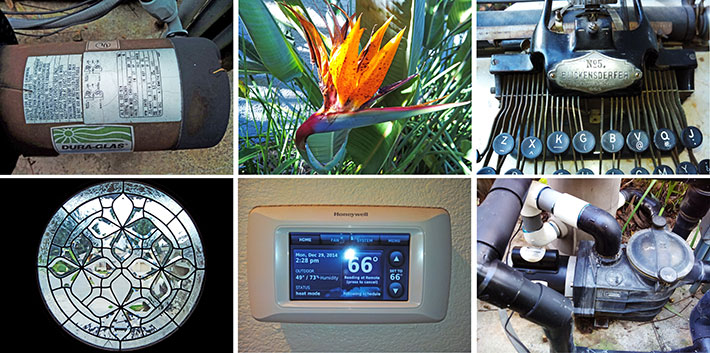
The Gladius 5 camera is capable of taking much better pictures than we generally see from industrial handhelds. There is very good sharpness and image detail, and little of the massive compression that often renders pictures from such integrated cameras useless.
Video is also significantly better than what we've come to expect from cameras integrated into rugged devices. Frame rate and focussing are quick and the camera doesn't fall behind. The maximum 1280 x 720 recording format is very useful, though we wish full 1080p were available also, especially since the imager should easily be able to do it.
The video to the right was taken with the Gladius 5 camera. It's an example of a clip that an automotive mechanic or tuner might shoot as an attachment to a work order.
Note that the camera applications that come with mobile operating systems are often replaced with third party applications optimized for certain tasks, or developers and systems integrators include camera and video functionality directly into custom applications.
In summary, the still image and video functions of the Gladius 5 are entirely good enough for virtually any documentation jobs.
Docking and charging
Unlike consumer smartphones where customers may want nothing more than a protective case, enterprise market device such as the Gladius 5 need mounting and docking options.
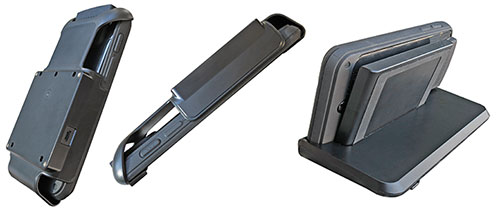 For that, ARBOR offers an in-vehicle docking mount with a wireless charger as well as a desktop cradle that also includes a wireless charger. For that, ARBOR offers an in-vehicle docking mount with a wireless charger as well as a desktop cradle that also includes a wireless charger.
The optional V-Dock lets users quickly insert and remove the device. The Qi-based wireless charging technology means there is no power cable to be inserted or removed from the Gladius handheld. The V-Dock has a standard VESA 4 x 75mm hole pattern and has therefore access to the whole catalog of RAM Mount mounting hardware (see examples of RAM VESA mount options).
The optional D-Dock allows using the Gladius in landscape orientation on a desk. It also uses Qi wireless charging technology.
Much tougher than consumer smartphones
Despite its elegance and iPhone-esque appearance, our detailed examination of its internal design and structure revealed that the Gladius 5 is very much a rugged device. This is one handheld that's much tougher than it looks.

First, the Gladius 5 carries IP65 sealing where the "6" means it's totally dustproof, and the "5" that it is also sealed against, according to the IP classification system chart, low pressure water jets from all directions. That's far better sealing that standard consumer smartphones have, but in an era where the likes of Samsung offer IP67-sealed versions of their consumer phones, we wonder why ARBOR didn't take the extra step and get the unit up to that level as well. it's not totally necessary, but knowing that one's tool could survive an inadvertent drop into a puddle or even shallow stream would offer additional peace of mind. And having perused the guts of this Gladius, it looks like it'd be simple to do.
The device can also handle drops from five feet. Consumer smartphones may survive a four foot drop inside a third party case, and even then there are no guarantees that they can survive a drop, let alone multiple drops.
The stated operating temperature range of 14 to 122 degrees Fahrenheit (-10 to 50 degrees Celsius) is wide enough to allow the device to be used almost anywhere.
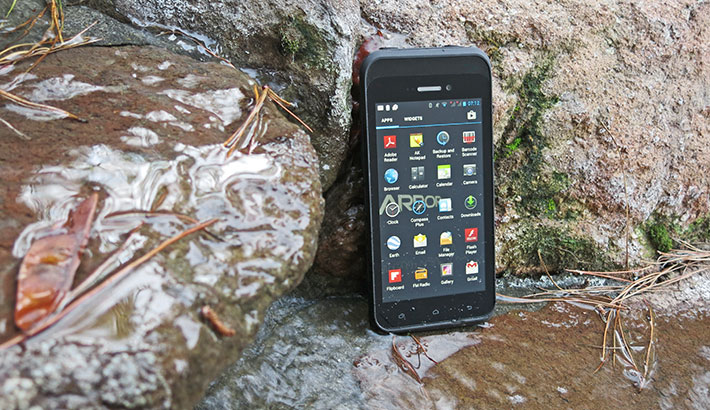
The display uses Corning Gorilla Glass 3 that provides even more protection against breakage and scratching than the first two generations. That's especially important in large-screen handhelds such as the Gladius 5.
As stated, the impressive strength provided by the internal magnesium frame suggests a high degree of toughness and ability to withstand accidents and abuse. ARBOR's literature mentions MIL-STD-810G certification, but does not say which MIL-STD-810G or similar tests, specifically, have been performed. Vibration, for example, can be a big issue if a device rattles around in a vehicle or if it's mounted on something that vibrates a lot. Users may also want to know its ability to handle tumbles, altitude, shock, and other punishment that may well be an issue in some of the more demanding IoT or even mPOS applications..
We're quite confident that the ARBOR Gladius 5 will hold up well in the field and under tough conditions. Its structure and design are first class, its sealing is exemplary, and Gorilla Glass protects the display, but we'd still like to see more official test results.
Summary: ARBOR Gladius 5 — a compelling Android handheld for IoT and numerous other professional applications
To say that the ARBOR Gladius 5 is an impressive piece of equipment would be a great understatement. Casual observers might at first sight mistake it for an iPhone 6 Plus or another of the new generation of large-screen smartphones. But the Gladius 5 is much more than that. Yes, it can do everything a state-of-the-art smartphone can do. But it's also fully rugged. And it can accommodate industrial-grade dedicated scanners.
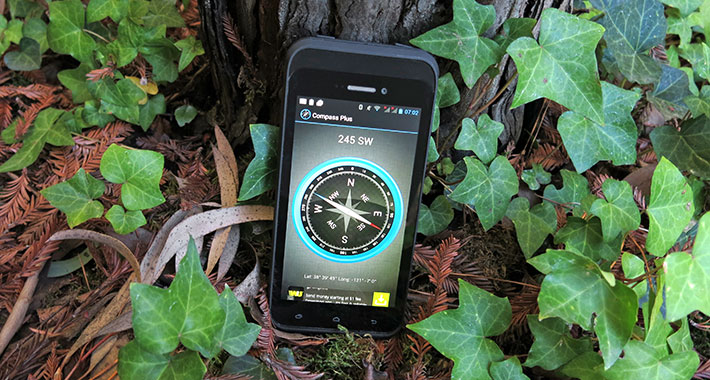
What that means is that the Gladius 5 can be used for a vast variety of applications. Its scanning and NFC capabilities make it a powerful mobile point of sale device. Its inherent ruggedness make it suitable for any number of field service, transportation and public safety deployments. It can easily be mounted in vehicles with its special V-Dock that even includes wireless charging. And its sleek looks and full modern smartphone capabilities make it perfect for numerous enterprise and business uses.
Sporting a large, bright, sharp (270 dpi) 5.5-inch capacitive multi-touch display with means it's in iPhone 6 Plus territory in terms of screen real estate. The replaceable battery lasts a full shift. There are dual SIMs for those who need to use multiple networks. There's either laser scanning or 2D imaging. There's a 13-megapixel documentation camera. The Gladius 5 survives 5-foot drops, can operate in icy cold and blistering heat, and its IP65 sealing means it doesn't mind dust or rain.
In summary, with the Android-powered Gladius 5, ARBOR provides an interesting, elegant-but-rugged "phablet" handheld entirely suitable for emerging Internet of Things projects, but also as a technologically advanced multi-purpose handheld for numerous warehousing, transportation, healthcare, mPOS and general industrial and enterprise deployments. And its starting price is no higher than that of an iPhone 6 Plus.
-- Conrad H. Blickenstorfer, January 2015
ARBOR Technology Gladius Gladius 5 Specs:
| Added/changed |
Added 09 2014, full review 01/2015
|
| Type |
Rugged Android IoT handheld
|
| Processor |
1.00GHz Quad-core Cortex A7 MediaTek MTK MT6589
|
| Graphics |
PowerVR Series5XT GPU
|
| OS |
Android 4.2
|
| Standard/Max RAM |
1GB/1GB |
| Disk/drive |
8GB onboard, plus microSD card storage |
| Display type |
TFT with anti-reflective coating and Gorilla glass protection; optional optical bonding for sunlight readability |
| Display size/resolution |
5.5-inch/XGA (1280 x 720 pixel) with anti-reflective properties |
| Digitizer |
Projected capacitive multi-touch |
| Keyboard/keys |
Onscreen
|
| Navigation |
Touch
|
| Expansion slots |
1 x microSDHC Card, 2 x SIM card
|
| Housing |
PC+ABS polymer over magnesium frame
|
| Size |
6.9 x 3.3 x 0.63 inches (176 x 84 x 16 mm)
|
| Weight |
9.9 oz. (280 grams) with battery
|
| Operating temperature |
14° to 122°F (-10° to 50°C) |
| Ingress protection |
IP65 (totally dustproof, sealed against low pressure water jets from all directions) |
| Humidity |
95% non-condensing |
| Drop |
26 5-foot drops |
| Vibration |
MIL-STD-810G testing |
| Altitude |
Unknown |
| Tumble |
Unknown |
| ESD |
Unknown |
| Power |
3.7V, 3,600mAh 13.32 watt-hour ("up to 8 hours"), Qi standard wireless charge supported |
| Regulatory |
FCC, CE, CB, UL, NCC. A-TICK/C-TICK, VCCI, Japan TELEC |
| Camera |
Front: 2.0mp (not available if equipped with scanner), rear: AF 12.6mp with LED |
| GPS |
TBD |
| Scanner |
Optional dedicated Honeywell N4313 1D laser scanner or Honeywell N5600 1D/2D imager |
| Sensors |
Ambient light, proximity, 3-axis accelerometer, 3-axis magnetic field, barometer |
| Communication |
802.11b/g/n, Class 2 Bluetooth 4.0 + EDR, NFC, WCDMA/GSM, GPS, A-GPS, 1D/2D imager with physical trigger |
| Interface |
1 x micro USB 2.0, audio in/out, dock |
| Price |
Starting at US$867 |
| Spec sheet |
 Gladius 5 brochure (PDF) Gladius 5 brochure (PDF)
|
| Web page |
Gladius 5 web page |
| Contact |
ARBOR Technology Corp.
10F., No.700, Zhongzheng Rd.
Zhonghe Dist., New Taipei City 235
Taiwan, R.O.C.
Tel: 886 2 8226 9396
Fax: 886 2 8226 9398 |
|



